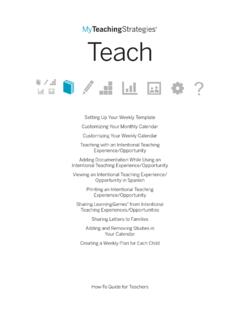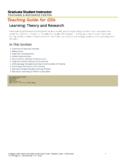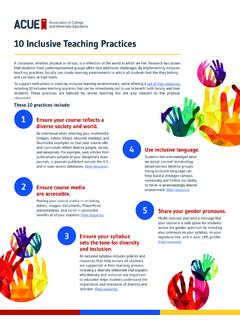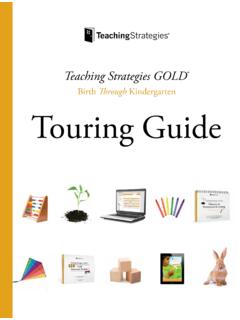Transcription of A CUNY-NYSIEB GUIDE FOR EDUCATORS
1 TRANSLANGUAGING: A CUNY-NYSIEB GUIDE FOR EDUCATORS Anita Sztukowska, Grade 9 CHRISTINA CELIC KATE SELTZER ii This GUIDE was developed by CUNY-NYSIEB , a collaborative project of the Research Institute for the Study of Language in Urban Society (RISLUS) and the Program in Urban Education at the Graduate Center, The City University of New York, and funded by the New York State Education Department. The GUIDE was written under the direction of CUNY-NYSIEB 's Project Director, Nelson Flores, and the Principal Investigators of the project: Ricardo Otheguy, Ofelia Garc a and Kate Menken.
2 For more information about CUNY-NYSIEB , visit Published in 2012 by CUNY-NYSIEB , The Graduate Center, The City University of New York, 365 Fifth Avenue, NY, NY 10016. This GUIDE was revised in 2013 to include the Appendix. Reprinted in March 2013. iii ABOUT THE AUTHORS Christina Celic Christina Celic is an educational consultant specialized in supporting emergent bilinguals academic and linguistic development. She provides professional development services for schools, districts, and non-profit organizations in New York, as well as nationally and internationally. Ms. Celic creates and conducts professional development centered on the topics of translanguaging, curriculum planning with emergent bilinguals, developing students academic language proficiency, differentiating instruction, and assessment with emergent bilinguals.
3 Ms. Celic is the author of English Language Learners Day by Day, K-6: A Complete GUIDE to Literacy, Content-Area, and Language Instruction, published by Heinemann in 2009. Ms. Celic has experience teaching emergent bilinguals in Grades 1-6 in both bilingual and ESL programs, first in Illinois and then in New York City. She has also worked as a literacy coach at a New York City school with a dual language bilingual program and an ESL program. Ms. Celic has taught in the Bilingual Education & TESOL department at City College of New York, cuny , and has been a guest lecturer for graduate-level courses at Teachers College, Columbia University and City College of New York, cuny .
4 Ms. Celic has a Masters in Bilingual Education from Teachers College, Columbia University, and a Bachelor of Arts in Spanish and Education from Indiana University. She holds professional teaching certification in Bilingual Education (Spanish), Childhood Education, and ESL. She herself is an emergent bilingual, speaking English, Spanish, and Portuguese. Kate Seltzer Kate Seltzer is a high school teacher in New York City. After graduating from college, Ms. Seltzer moved to Central America, where she lived and worked at Casa Guatemala, an NGO that cares for and educates orphaned children in rural Rio Dulce, Guatemala. When she moved back to the States, Ms.
5 Seltzer joined the New York City teaching Fellows and began teaching English at a small high school in the South Bronx, where she was first introduced to educating emergent bilinguals. As both a teacher and a grade level team leader, Ms. Seltzer helped shape the ESL program at her high school, implementing new practices for teaching EBLs, including a large population of SIFEs and LTELs , and creating systems that helped meet the needs of all EBLs in the school. Ms. Seltzer currently teaches 9th and 10th grade English at a small performing arts school in Manhattan. In addition to classroom teaching , Ms. Seltzer also plans and facilitates staff professional development around the Common Core State Standards.
6 She is also an adjunct lecturer in the Bilingual Education & TESOL department at City College of New York, cuny , where she teaches classes on methods of TESOL and teaching literacy to speakers of other languages. Ms. Seltzer holds a Masters in English Education from Lehman College, and a Bachelor of Arts in English and Women s Studies from The George Washington University. She is currently a candidate in the Urban Education department at the cuny Graduate Center. Like Ms. Celic, Ms. Seltzer is herself an emergent bilingual, speaking English, Spanish, and her mother s home language, Italian. iv CONTENTS Theorizing Translanguaging for EDUCATORS 1 Ofelia Garc a How to Use this Translanguaging GUIDE : The Collaborative Descriptive Inquiry Process 7 Ofelia Garc a & Laura Ascenzi-Moreno About This GUIDE 11 Part 1: THE TRANSLANGUAGING CLASSROOM Multilingual Ecology Essential Questions - How can we create a classroom and school environment that celebrates students home languages and cultures?
7 - How can we raise ALL students awareness of the different languages and scripts in their communities? Translanguaging Strategies: A Culturally Relevant Learning Environment 13 A Multilingual Learning Environment 20 Language Portfolio 23 Community Study 40 Instructional Foundations Essential Questions - How can we design instruction that promotes translanguaging? - How can we make space for students to utilize their multiple languages to negotiate academic content?
8 Translanguaging Strategies: Multilingual Language Objectives 44 Integrated Instruction 51 Designing Units around Multilingual Culminating Product 57 Collaborative Work Essential Questions - How can we design collaborative work that encourages students to use both their home languages and English to make meaning? - How can multilingual collaborative work build students listening and speaking skills? Translanguaging strategies: E M S E M S E M S E M S E M S E M S E M S v Multilingual Collaborative Work: Content Areas 62 Multilingual Collaborative Work: Reading Groups 68 Multilingual Writing Partners 72 Multilingual Reading Partners 76 Translanguaging Resources Essential Questions - How can we use resources in students home languages for each genre/topic studied?
9 - How can we help emergent bilinguals develop background and content knowledge? - How can multilingual resources build students listening and reading skills? Translanguaging Strategies: Using Multilingual Texts 81 Multilingual Listening Center 87 Bilingual Dictionaries & Picture Dictionaries 92 Internet as a Multilingual Resource 96 Part 2: CONTENT & LITERACY DEVELOPMENT Content-Area & Reading Instruction Essential Questions - How can we build students reading and listening ability through the use of all of their languages? - How can we build students content knowledge through the use of all of their languages?
10 - How can we provide rigorous cognitive engagement for students? Translanguaging Strategies: Building background with Preview-View-Review 100 Multilingual Research 107 Comparing Multilingual Texts on the Same Content-area Topic 112 Multilingual Reading and Responses 118 Content-Area & Writing Instruction Essential Questions - How can we build students writing ability through the use of all of their languages? - How can we build students content knowledge through the use of all of their languages? - How can we provide rigorous cognitive engagement for students? E M S E M S E M S E M S E M S E M S E M S E M S E M S M S E E M E M S vi Translanguaging Strategies: Translanguaging with Interactive Writing 122 Translanguaging with Language Experience Approach 127 Translanguaging with Independent Writing 132 Translanguaging with Multi-genre Writing 142 Part 3: LANGUAGE DEVELOPMENT Vocabulary Essential Questions - How can we scaffold students understanding of English vocabulary words?





